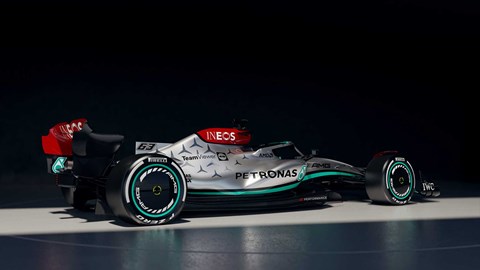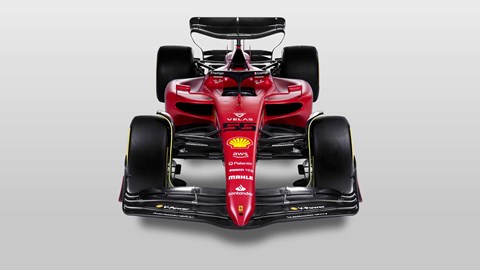► F1 2021 was a mess, but it’s a new year
► The biggest rule change for years
► Tom Clarkson expxlains all
The shadow cast by last year’s Abu Dhabi finale is a long one. F1 lives under it still. The drama of those closing laps continues to be debated in the pitlane. But from that murk a fresh optimism has emerged. The FIA, the sport’s governing body, has reacted to the farrago in Sakhir by re-structuring race control. At the same time new technical regulations are providing the sport with a much-needed reset. For now we must wait: wait to find out if two race directors, supported by a VAR system, are better than one, now that Michael Masi has been demoted; and wait to find out if the new cars will encourage more overtaking and change the pecking order.
Mercedes have won eight consecutive manufacturers’ world titles since 2014; will the new regs be their undoing?‘We don’t make mistakes,’ said Lewis Hamilton after only a handful of laps in his new W13. Punchy.

The technical changes represent the biggest upheaval the sport’s seen in 40 years. The likes of Red Bull’s design chief Adrian Newey relish such challenges, while others are intimidated. Who can blame them: the new cars are 43kg heavier than last year and they generate downforce in a different way. Gone is the reliance on front and rear wings; the holy grail is now under-car aero performance, or ground-effect.
It’s not new to F1 but it hasn’t been permitted in the regulations since 1982. The new regs have been three years in the making and F1’s rule makers, led by the hugely experienced Pat Symonds, have invested a lot of time in tidying up the cars’ wake. The dirty air is now thrown up high, in the hope that the cars will be able to follow each other more closely.
‘I think they’ve achieved that,’ says reigning champ Max Verstappen. ‘I’ve followed other cars and it does feel better; you don’t get the understeer, or snaps of oversteer like in the past.’
There’s more. Low-profile 18-inch tyres have been introduced to more closely mirror the cars we drive on the road; the fuel is now 10 per cent ethanol and there’s a budget cap of $140 million ($5m lower than last year). Unsurprisingly, there are huge differences between the cars.
The Ferrari has beautifully sculpted sidepods; the Red Bull has a high nose; the McLaren has trick front suspension; and the Mercedes looks emaciated, its body-work shrink-wrapped around the power unit. Despite the changes, the cars remain breathtakingly fast.

The drivers haven’t noticed any difference in speed to last year through quick corners and, while they’re slower through the twistier stuff, lap times are only two seconds off 2021’s. At the first test the level of reliability was also astonishing. Verstappen’s Red Bull managed 147 laps on the opening day, fresh out of the box. To put that in perspective, he managed only 138 laps on the opening day of 2021 in a car that was 12 months old.
It hasn’t all been plain sailing. The cars have been porpoising (bouncing off the track surface at high speed), such is the level of suction created by the new venturi tunnels. Mercedes new boy George Russell even called it a safety concern, but F1 boss Ross Brawn said the teams will find a fix: ‘We had something similar when I was at Williams in the early ’80s; we found a solution.’The new cars look fabulous, fast and an interesting challenge for the drivers. Roll on the first race in Bahrain. With any luck it’ll banish for good any hangover from Abu Dhabi.

The GOAT returns
There was doubt as to whether Lewis Hamilton would return at all after the off-season. He withdrew from social media and Mercedes were unable to confirm until immediately pre-season that he would be back in the car.‘I like to think that while moments like this [losing the title in Abu Dhabi] might define other people’s careers, I refuse to let this define mine,’ Hamilton told the media pre-season. ‘If you think last year was my best, wait until you see this year.’
Ferrari is back
Ferrari topped the time sheets on day two with a supremely handsome car that calls to mind the classic liveries of yesteryear. You almost expect to see Prost and Mansell’s names on the lap chats rather than Leclerc and Sainz… Uglier was the porpoising many of the cars, the Ferrari included, battled throughout the test. Prompted by a cyclical loss and then resumption of downforce, the key will be curing it without losing performance.
What about McLaren?
McLaren bolted out of the gates with competitive times immediately, on both low and high fuel loads and over longer stints managing tyre wear. The new tyres are another 2022 challenge, with far slimmer and stiffer sidewalls than the balloon-like slicks they’ve become used to.
George gets his chance

Lewis Hamilton has a new team-mate: George Russell. Three seasons at underperforming Williams make it tricky to judge just how quick he’ll be (although very nearly winning on his one super-sub appearance in a Mercedes in 2020 gives a good clue). A potential Hamilton versus Russell battle is a mouthwatering prospect.
Red Bull carries on where it left off?
Red Bull Racing were concentrating on last year’s hard-fought championship battle to the very last lap of 2021, which may have cost them development time for 2022. Chief technical officer Adrian Newey is famous for coming out of the blocks flying whenever there’s a major technical reg shake-up. RBR will be hoping this year’s car is another Newey masterstroke.
More improvements for Alpha Tauri
Red Bull junior team AlphaTauri had a stellar 2021. They also made a strong start to 2022, being the second team (behind Aston Martin) to run their car on track. At Barcelona there were hints of searing speed – at the end of day two, GP winner and white-hot talent Pierre Gasly’s quickest time was third fastest, behind Norris and Leclerc.